Holbeach, Lincolnshire
Up to 1834
A parliamentary report of 1777 recorded parish workhouses in operation at Holbeach for up to 35 inmates, and at Sutton—St Mary's for up to 20.
The Holbeach parish workhouse was located in a row of cottages at the southern end of Penny Hill Road, a little way to the north of the town. The building survived until the 1960s but modern housing now occupies the site,

Holbeach former parish workhouse site, 1886.
After 1834
Holbeach Poor Law Union was officially formed on 7th December 1835. Its operation was overseen by an elected Board of Guardians, 25 in number, representing its 11 constituent parishes as listed below (figures in brackets indicate numbers of Guardians if more than one):
County of Lincoln: Fleet; Gedney (3); Gedney Hill Chapelry; Holbeach (6); Lutton; Sutton, St Edmunds; Sutton, St James; Sutton, St Mary (5); Tydd, St Mary (2); Whaplode Drove; Whaplode (3).
The population falling within the union at the 1831 census had been 14,737 with parishes ranging in size from Gedney Hill Chapelry (population 371) to Holbeach itself (3,800). The average annual poor-rate expenditure for the period 1833-35 had been £10,364 or 14s.8d. per head.
The new workhouse was built in 1836-7 at the north side of Fleet Road at the east of Holbeach. The architect was Robert Ellis Junior. It was designed to accommodate 386 people and the Poor Law Commissioners authorized an expenditure of £4,830 for its construction.
The workhouse was based on the Poor Law Commissioners' standard Y-plan or hexagonal designs produced by Sampson Kempthorne. It comprised a three-storey entrance block facing onto the road, behind which three accommodation wings radiated from a central hub. A separate 36-bed infirmary was added at the north-west of the site in 1851 and extended in 1904 after which it could accommodate 80 patients (51 men and 29 women).
The workhouse location and layout is shown on the 1886 map below.
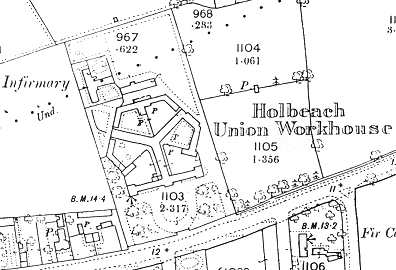
Holbeach workhouse site, 1886.
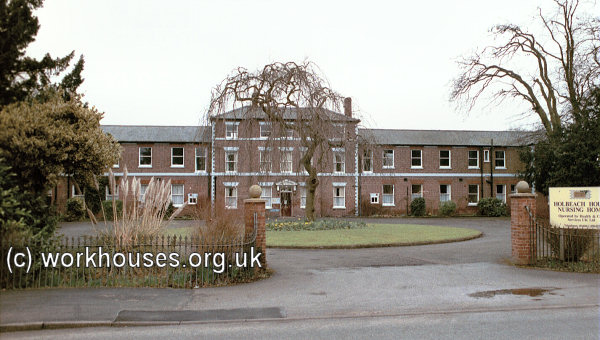
Former Holbeach workhouse entrance from the south, 2001.
© Peter Higginbotham.
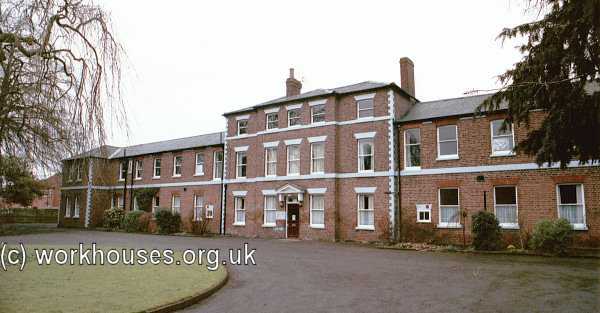
Former Holbeach workhouse entrance block from the south-east, 2001.
© Peter Higginbotham.
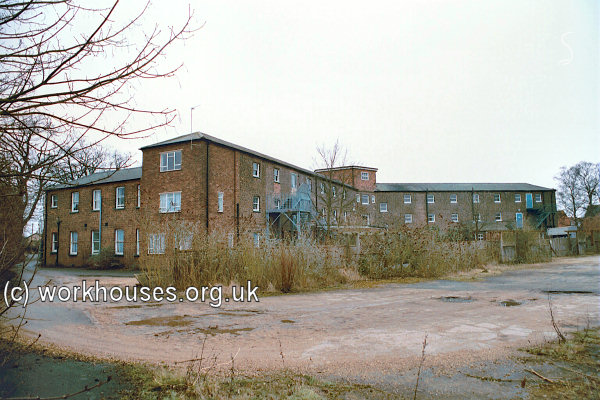
Former Holbeach workhouse accommodation ranges block from the north-east, 2001.
© Peter Higginbotham.
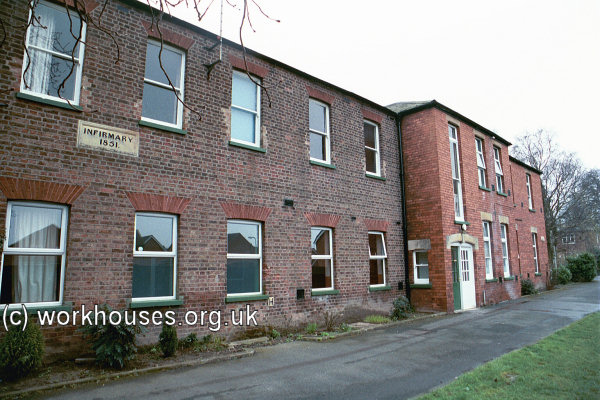
Former Holbeach workhouse infirmary block from the north-west, 2001.
© Peter Higginbotham.
The workhouse received some unwelcome publicity in April 1882 when the master, Walter Brydges Waterer, was accused of the manslaughter of a workhouse inmate, 22-year-old Thomas Bingham. Waterer had left the man in a sulphur-burning cabinet, which was being used as a treatment for 'the itch', or scabies. The box had a moveable lid, in which the patient stood with his head out of the top. The sulphur was placed on iron tray at the bottom of the box, beneath a grating, and ignited by a piece of hot iron. Bingham was then placed naked in the box with his neck through the lid, while the master attended to a matter elsewhere. Bingham's cries at length attracted attention and he was released, but not until he had been so terribly burned that skin and flesh fell from different parts of his body. He died a few hours afterwards.
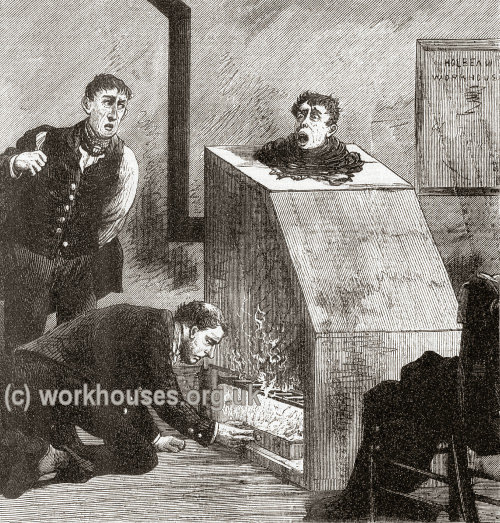
An illustration of the 1882 Holbeach workhouse scandal.
© Peter Higginbotham.
Waterer was committed for trial on a charge of manslaughter but was found not guilty. Following further complaints that he had on various occasions been drunk on duty, and had turned out a woman and her two young children from the casual at 10pm one night, he resigned his post. In September 1882, the Guardians of the Westbury-on-Severn union appointed him master of their workhouse. At their next meeting, a fortnight later, they agreed not to confirm the appointment as Waterer had "withheld information which has since come to the board's knowledge." Presumably Waterer's past had caught up with him.
From 1904, to protect them from disadvantage in later life, the birth certificates for those born in the workhouse gave its address just as The Shrubbery, Fleet.
After 1930, the workhouse became Holbeach Public Assistance Institution. After 1948, as part of the new National Health Service, it became Fleet Hospital. In more recent times, the site has operated as Holbeach House nursing home. In October 2014, plans were announced for converting the buildings for residential use.
Staff
Inmates
Records
Note: many repositories impose a closure period of up to 100 years for records identifying individuals. Before travelling a long distance, always check that the records you want to consult will be available.
- Lincolnshire Archives, St. Rumbold Street, Lincoln LN2 5AB. Holdings include Guardians' minute books (1835-1930); Admissions and discharges (1904-5, 1913-16, 1929-33); Deaths (1914-1936); etc.
Bibliography
- Higginbotham, Peter The Workhouse Encyclopedia (2014, The History Press)
Links
- None.
Unless otherwise indicated, this page () is copyright Peter Higginbotham. Contents may not be reproduced without permission.


